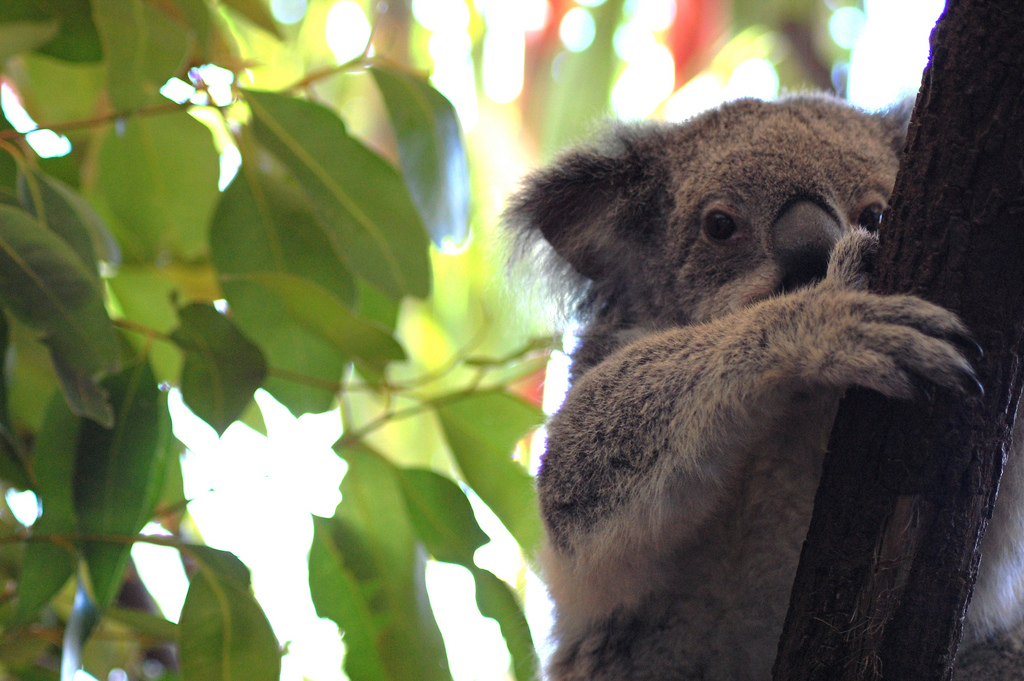
Koala Net is a good example of an online dictionary of slang. Photo © Micki Takes Pictures, licensed Creative Commons Attribution No-Derivatives.
Spend even a brief time on a bus, train, or tram and you’ll truly appreciate the variety in the Australian language. You’ll barely understand some people, with the thick accent, distinctive drawl, and slight upward inflection at the end of sentences that sounds like they might be asking a question. Others have a barely noticeable accent, and most people are somewhere in between. In general, the use of Australian slang words by new arrivals is a no-no; it’s just too difficult to understand the nuances, and a well-meant phrase can easily be offensive.Like anywhere, differences in language use are usually connected to education and social class, even though Australians will insist their society has no class differences. One thing most Australians have in common is the almost inevitable shortening of every expression. An avocado becomes an “avo,” a tradesperson becomes a “tradey,” a U-turn is a “youie,” and football is “footy.” Even your name is not safe and will inevitably be abbreviated.Aside from the Australian dialect itself, which can vary among cities and states and by social class, Australia has three types of language differentiation: slang expressions that are common to nearly all Australians; rhyming slang, which crosses social and geographic boundaries and is virtually impossible to comprehend; and Strine, the “ocker” accent and vocabulary that at times feels like a whole new language, replete with unique expressions and words.
Not all Australians use Aussie slang extensively. You may have to wait to hear your first “g’day,” and like all slang, phrases common in one generation do not always carry over to the next. Aussies do not really call each other “cobber” except on rare and often ironic occasions, despite the universal presence of the word in dictionaries of common Aussie slang. Righto is also fading out, although it has been popular for several generations. Words like swagman and billabong that feature in popular songs like Waltzing Matilda are no longer in common usage. But mastering slang—at least understanding it—is essential for following even average-length conversations of moderate complexity. Get a decent online or printed dictionary of slang and read it through once, have a giggle, and familiarize yourself with the sound of the phrases and words. A good example is Koala Net.
Next, keep an ear out for unusual words from Aussies you know, write them down if you like, and look them up— having a smart phone with an app or at least the Internet handy is very helpful at times. You’ll find, for example, that some cases of slang are impossible to figure out logically, and some seem to be real words in their own right. A news report might describe someone being “king hit”; no amount of rational analysis would tell you that it means being knocked out cold.
In general, the use of Australian slang words by new arrivals is a no-no; it’s just too difficult to understand the nuances, and a well-meant phrase can easily be offensive. Generally speaking, the use of diminutives and basic words like g’ day are safe to use when around your “mates,” but any more than that is often misinterpreted as insulting.
Certain words in common usage elsewhere should not be used in Australia: fanny, root (as in “root for the home team”), and bung (as in “I bunged my car right into the wall”). These have vulgar meanings in the Australian idiom. Bastard can be a term of affection in Australia, but avoid trying to use it unless you really know the people well.
The prevalent rhyming slang of Australia needs to be explained to be understood. For example, to “have a Captain Cook” is rhyming slang for “have a look.” Rhyming slang is often combined with the diminutive: Yank rhymes with septic tank, which becomes seppo, a derisive slang term for Americans. Trouble becomes rubble, then Barney Rubble, which becomes barney, so that a “friend in barney” needs your help. A bone, from dog and bone, is a phone; a Noah, from Noah’s Ark, is a shark; and so it goes in every increasing circles. It is colorful and is only learned by example.
Beyond Australian slang, which is common to most Australians, there is an extensive vocabulary and a strongly drawled accent known as Strine. Someone who speaks Strine is an “ocker” (OCK-ah). Strine is known as Broad Australian English and generally reflects the working class. The classic ocker says “yous” for the plural of you, “good on ya” for “well done,” and “me” instead of “my” as in “tie me kangaroo down, sport.”
Excerpted from the Second Edition of Moon Living Abroad in Australia.